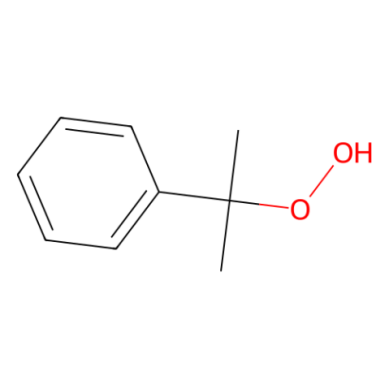Cumene Hydroperoxide (CMHP, CHP)
_%E8%8B%B1%E6%96%87.jpg?access_token=05c73628-1c76-4153-85ab-a940eb9528db)
Product Manager:Nick Wilde
Cumene hydroperoxide is a stable organic peroxide that can be found commercially with a purity of approximately 80%. When dissolved in benzene at a concentration of 0.2 M, it has a half-life of 29 hours at 145°C. The decomposition of cumene hydroperoxide results in the production of methylstyrene, acetophenone, and cumyl alcohol. Although pure cumene hydroperoxide can be stored at room temperature, it has a high potential for uncontrolled reaction and explosion. Additionally, cumyl and other hydroperoxides are susceptible to rapid decomposition when exposed to various trace compounds, including acids and metals. (M. A. Francisco, Chem. Eng. News, 1993, 71, 4.).

Recent Literature

A novel catalytic system has been devised for the asymmetric epoxidation of allylic alcohols, demonstrating remarkable enantioselectivity towards Z-olefins. This system boasts a low catalyst loading of less than 1 mol%, operates at temperatures ranging from 0°C to room temperature within a shorter timeframe, and employs simplified workup procedures for the synthesis of small epoxy alcohols.
W. Zhang, A. Basak, Y. Kosugi, Y. Hoshino, H. Yamamoto, Angew. Chem. Int. Ed., 2005, 44, 4389-4391.
https://doi.org/10.1002/anie.200500938

Employing chiral bishydroxamic acid ligands in the vanadium-catalyzed asymmetric epoxidation of homoallylic alcohols achieved outstanding yields and exceptional enantioselectivities.
W. Zhang, H. Yamamoto, J. Am. Chem. Soc., 2007, 129, 286-287.
https://doi.org/10.1021/ja067495y
The incorporation of chiral bishydroxamic acid ligands into the vanadium-catalyzed asymmetric epoxidation of homoallylic alcohols led to superior yields and unparalleled enantioselectivities.
R. Kino, K. Daikai, T. Kawanami, H. Furuno, J. Inanaga, Org. Biomol. Chem., 2004, 2, 1822-1824.
https://doi.org/10.39/b405882h
Utilizing a readily accessible cinchona alkaloid catalyst, we have successfully developed efficient enantioselective peroxidation and epoxidation processes. By harnessing commonly available α,β-unsaturated ketones and hydroperoxides, this innovative reaction offers exciting prospects for the asymmetric synthesis of chiral peroxides and epoxides.
X. Lu, Y. Liu, B. Sun, B. Cindric, L. Deng, J. Am. Chem. Soc., 2008, 130, 8134-8135.
https://doi.org/10.1021/ja802982h
A metal-free I2/CHP-mediated cross-coupling reaction between isocyanides and readily accessible amines effectively produces carbodiimides in good yields. This method offers an efficient pathway for the synthesis of both symmetric and unsymmetric functionalized carbodiimide derivatives under mild conditions.
T.-H. Zhu, S.-Y. Wang, Y.-Q. Tao, S.-J. Ji, Org. Lett., 2015, 17, 1974-1977.
https://doi.org/10.1021/acs.orglett.5b00722
A unique mechanism facilitates Suzuki-Miyaura-like cross-couplings between alkyl iodides and aryl organoborons. While utilizing a copper catalyst, this process relies on the halogen-atom-transfer capability of α-aminoalkyl radicals to activate secondary alkyl iodides into alkyl radicals, which subsequently undergo coupling with boronate species.
Z. Zhang, B. Górski, D. Leonori, J. Am. Chem. Soc., 2022, 144, 1758-1765.
https://doi.org/10.1021/jacs.1c12649
A highly enantioselective α-hydroxylation of β-keto esters is achieved using a chiral (1S,2S)-cyclohexanediamine backbone salen-zirconium(IV) complex as the catalyst, with cumene hydroperoxide (CHP) serving as the oxidant. This method provides chiral α-hydroxy β-keto esters in outstanding yields and enantioselectivities, and the zirconium catalyst is recyclable, allowing for gram-scale reaction execution.
F. Yang, J. Zhao, X. Tang, G. Zhou, W. Song, Q. Meng, Org. Lett., 2017, 19, 448-451.
https://doi.org/10.1021/acs.orglett.6b03554
In the presence of strong bases, nitroarenes undergo a reaction with anions derived from tert-butyl and cumyl hydroperoxides, leading to the formation of substituted o- and p-nitrophenols. This process typically occurs with high yields, making it a valuable synthetic and manufacturing method for nitrophenols.
M. Makosza, K. Sienkiewicz, J. Org. Chem., 1998, 63, 4199-4208.
https://doi.org/10.1021/jo970726m
Quoted
from:https://www.organic-chemistry.org/chemicals/oxidations/cumene-hydroperoxide-cmhp.shtm
Aladdin:https://www.aladdinsci.com






